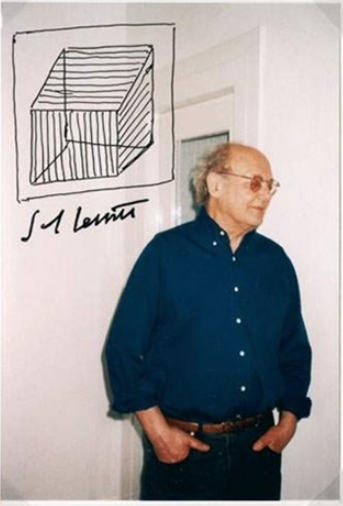Sol LeWitt
Was born in Hartford, Connecticut, in 1928. He attended at the University of Syracuse (New York). In the mid-fifties he worked as sketcher and graphical designer for architect I. M. Pei. In 1960 he found a job in the Museum of Modern Art of New York where he would contact with the art that then began to break with the abstract expressionism. There he would know other young artists who made tasks in the museum: Dan Flavin, Robert Ryman, Robert Mangold, Scott Burton. In 1964 he leaves this work and he gets concentrated in the production of his own work. In this period, LeWitt begins to work in works based on modular structures.
In 1965, he makes his first individual exhibition in which he presents pieces in three dimensions of clear and defined lines that cut the space. After this experience, LeWitt turns upside down to the accomplishment of open structures. The cube is transformed by its simplicity into the fundamental figure on which LeWitt virtually constructs an infinite series of combinations. Using mathematical systems, LeWitt was against the expression and the gesture of the abstract expressionism that reigned in the ' 50s.
In 1967, he publishes his famous Paragraphs on Conceptual Art, text that would be transformed into a manifesto of the movement of conceptual art that arose at that time. At that moment, he searched for simple forms and logics that allow him to put in background the accomplishment process. The interest center is tie to the idea that originates the work and not to its effective construction: "In the conceptual art the idea or concept is the most important aspect of the work. When an artist uses a conceptual form of art, it means that all of the planning and decisions are made beforehand and the execution is a perfunctory affair ".
At the end of the of the ' 60s, LeWitt begins to make his wall drawings, works that would be transformed into his distinguishing mark throughout the years. The direct intervention on the wall allows LeWitt to play with different geometric forms that invade the space through the force of his lines and colors. During the ' 70s he develops this type of works, together with new structures and drawings, exploring their theoretical and aesthetic possibilities.
In the decade of the ' 80s, he continues working with structures and he transforms the simple lines that had originated the wall drawings in bands: the squares are replaced by cubes and the triangles by pyramids, entering into a narrower relation with the architectonic space. In the middle of the decade he incorporates blocks of concrete for his structures. In the last years, LeWitt has been dedicated to make works by order for specific sites, concentrating himself in the challenges that each individual place presents. In 1997, he incorporates the acrylic painting to the accomplishment of his drawings, technique that is possible to appreciate in this exhibition at Proa Foundation.
 Sol LeWitt
Sol LeWitt